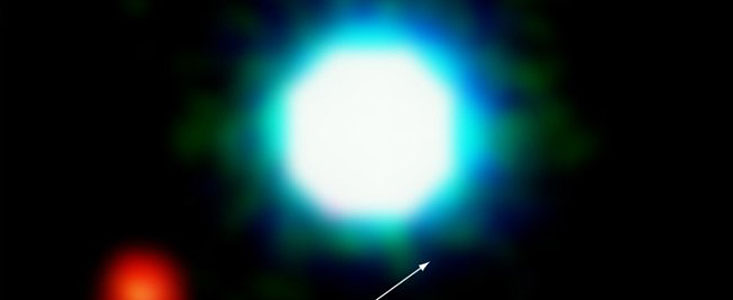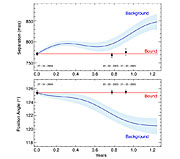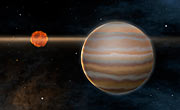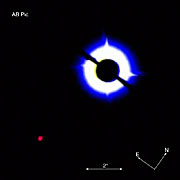Pressmeddelande
Yes, it is the Image of an Exoplanet
Astronomers Confirm the First Image of a Planet Outside of Our Solar System
30 april 2005
An international team of astronomers reports today confirmation of the discovery of a giant planet, approximately five times the mass of Jupiter, that is gravitationally bound to a young brown dwarf. This puts an end to a year long discussion on the nature of this object, which started with the detection of a red object close to the brown dwarf.
In February and March of this year, the astronomers took new images of the young brown dwarf and its giant planet companion with the state-of-the-art NACO instrument on ESO's Very Large Telescope in northern Chile. The planet is near the southern constellation of Hydra and approximately 200 light years from Earth.
"Our new images show convincingly that this really is a planet, the first planet that has ever been imaged outside of our solar system," tells Gael Chauvin, astronomer at ESO and leader of the team of astronomers who conducted the study.
"The two objects - the giant planet and the young brown dwarf - are moving together; we have observed them for a year, and the new images essentially confirm our 2004 finding," says Benjamin Zuckerman, UCLA professor of physics and astronomy, member of NASA's Astrobiology Institute, and a member of the team. "I'm more than 99 percent confident." The separation between the planet and the brown dwarf is 55 times the separation of the Earth and Sun.
Anne-Marie Lagrange, another member of the team from the Grenoble Observatory in France, looks towards the future: "Our discovery represents a first step towards one of the most important goals of modern astrophysics: to characterize the physical structure and chemical composition of giant and, eventually, terrestrial-like planets."
Last September, the same team of astronomers reported a faint reddish speck of light in the close vicinity of a young brown dwarf. The feeble object, now called 2M1207b, is more than 100 times fainter than the brown dwarf, 2M1207A. The spectrum of 2M1207b presents a strong signature of water molecules, thereby confirming that it must be cold. Based on the infrared colours and the spectral data, evolutionary model calculations led to the conclusion that 2M1207b is a 5 Jupiter-mass planet. Its mass can be estimated also by use of a different method of analysis, which focuses on the strength of its gravitational field; this technique suggests that the mass might be even less than 5 Jupiters.
At the time of its discovery in April 2004, it was impossible to prove that the faint source is not a background object (such as an unusual galaxy or a peculiar cool star with abnormal infrared colours), even though this appeared very unlikely. Observations with the Hubble Space Telescope, obtained in August 2004, corroborated the VLT/NACO observations, but were taken too soon after the NACO ones to conclusively demonstrate that the faint source is a planet.
The new observations show with high confidence that the two objects are moving together and hence are gravitationally bound.
"Given the rather unusual properties of the 2M1207 system, the giant planet most probably did not form like the planets in our solar system," says Gael Chauvin. "Instead it must have formed the same way our Sun formed, by a one-step gravitational collapse of a cloud of gas and dust."
The paper describing this research has been accepted for publication in Astronomy and Astrophysics.
The same European/American team has had another paper just accepted for publication in Astronomy & Astrophysics; this paper reports the imaging discovery with the same VLT/NACO instrumentation of a lightweight companion to AB Pictoris, a young star located about 150 light years from Earth. The estimated mass of the companion is between 13 and 14 times the mass of Jupiter, which places the companion right on the border line between massive planets and the lowest mass brown dwarfs.
Among the most essential quests of modern astronomers, taking direct images of planets outside of our solar system is certainly up there among chart-toppers. Obtaining such images of a so-called exoplanet would enable scientists to study in detail the physical nature of the object and, in particular, to analyse the composition of its atmosphere. The astronomers' ultimate goal is of course to perform such analysis for earth-sized planets, in the hope of detecting a telltale signature of extraterrestrial life.
Such an ultimate objective is still at least decades in the future, as earth-size and even Jupiter-size planets around stars as old as the Sun are too faint to be detected by present-day technology.
Nevertheless, great progress can be achieved by taking images of giant planets orbiting much younger objects. Because giant planets a few tens of millions of years old are much hotter and brighter than their older brethren, they can be much more easily detected. Moreover, as the first tens of millions of years are considered to have been a critical period in the formation of Earth and of our own solar system, the study of nearby young planetary systems provides astronomers with invaluable insight on our own origins, something that is difficult if not impossible to decipher from investigation of old, mature planetary systems.Several surveys are therefore currently in progress that particularly aim at finding and taking direct images of sub-stellar companions - brown dwarfs and exoplanets - close to very young objects. Last year, an international team of astronomers [2] reported the first image of a Giant Planet Companion to 2M1207. On NACO/VLT images obtained in April 2004, they detected a faint reddish speck of light in the close vicinity of this young brown dwarf member of the 8 million year old TW Hydrae Association. The feeble companion, now called 2M1207b, is more than 100 times fainter than the brown dwarf, 2M1207A. The spectrum of the companion presents the strong signature of water molecules. Based on the infrared colours and the spectral data, evolutionary model calculations lead to the conclusion that 2M1207b is a 5 Jupiter-masses planet [3]. Its mass can be estimated also by use of a different method of analysis which focuses on the strength of its gravitational field; this technique suggests that the mass might be even less than 5 Jupiter mass.
In April 2004, the spectroscopic and photometric analysis strongly indicated a planetary mass object close to the star. An alternative explanation, that the faint detected object was a background source unrelated to the young brown dwarf (such as an extragalactic object or a peculiar cool star with unusual infrared colours), appeared very unlikely. Observations with the Hubble Space Telescope, obtained in August 2004 (i.e. only 4 months later), corroborated the VLT/NACO observations, even though they were obtained too soon after the NACO ones to provide a definite answer. Additional observations at a later epoch were required to prove beyond any doubt that the two objects, 2M1207A and 2M1207b, indeed move together in the sky and are therefore gravitationally bound to each other.
Such additional observations have now just been performed by the same team of European and American astronomers. They used again NACO on Yepun, the fourth 8.2-m Unit Telescope of ESO's Very Large Telescope [4]. The team took new images in February and March 2005 and measured the apparent motion on the sky of the young brown dwarf. For the three different epochs (April 2004, February and March 2005), they then accurately determined the relative position of the Giant Planet Companion with respect to the brown dwarf.
These observations show, with high accuracy, that there is no change in relative position between the two objects. This is exactly what one expects over a time scale of one year if 2M1207b is gravitationally bound to its host 2M1207A [5]. Over much longer time spans, we should see the two objects orbiting around each other.
For Gael Chauvin, astronomer at ESO and leader of the team of astronomers who conducted the study, "this new set of NACO measurements unambiguously confirms that 2M1207b is a planetary mass companion to the young brown dwarf 2M1207A. The image released last year is thus truly the first image ever taken of a planet outside of our solar system."
"The two objects - the giant planet and the young brown dwarf - are moving together; we have observed them for a year, and the new images essentially confirm our 2004 finding", says Benjamin Zuckerman, UCLA professor of physics and astronomy, member of NASA's Astrobiology Institute, and a member of the team. "I'm more than 99 percent confident. This would also be the first time that a planet outside of our solar system has been detected far from a star or brown dwarf - nearly twice as far as the distance between Neptune and the sun."
"Given the rather unusual properties of the 2M1207 system, the giant planet most probably did not form like the planets in our solar system," says Gael Chauvin. "Instead it must have formed the same way our Sun formed, by a one-step gravitational collapse of a cloud of gas and dust.
In the course of the same survey, the astronomers also discovered an interesting companion to the young star AB Pictoris of the 30 million years old Tucana-Horlogium Association located about 150 light years from Earth. This companion, imaged for the first time in March 2003, has a near-infrared luminosity and spectrum which points to a light and cool object.
Using the same strategy as for 2M1207b, the astronomers observed the AB Pic system at different epochs over a time span of a year and a half and confirmed that the companion is not a background object. Evolutionary model calculations point to a 13 to 14 Jupiter masses object with a temperature of ~1700 Kelvin. As the presently accepted separation between a high mass planet and a low mass brown dwarf is at 13.6 Jupiter masses [6], the newly discovered companion thus may lie at the exact boundary between these two classes of sub-stellar objects. It might therefore play the role of a unique "Rosetta stone" in the future. Remarkably, this companion is located very far from its host star - about 9 times further from AB Pictoris than Neptune is from the Sun. Nothing like this situation has ever been seen before in a planetary system.
Recently, a group of German astronomers presented evidence, based on VLT/NACO data, for a sub-stellar companion to the 1 million year old star GQ Lup. However, the precise nature of this sub-stellar companion is still unknown as the very young age of the system makes comparison with theoretical models quite complicated. It was therefore only possible to assess with certainty that the close companion to GQ Lup has most probably a mass between 1 and 42 Jupiter-masses, and therefore could be either an exoplanet or a brown dwarf.
The discovery of 2M1207b, AB Pic b and GQ Lup b/B, all within a short period of time, bring evidence that new, carefully designed surveys, using state-of-art instruments on the most advanced facilities, can provide astronomers with images of planetary companions.
The first image of an exoplanet may now have been taken and confirmed and there can be little doubt that others will follow soon. The detailed study of a growing number of exoplanets with different masses and orbital properties will provide insight on theoretical formation models and afford a unique opportunity to learn more about how the solar system formed, hence about our own origins.
Anne-Marie Lagrange, another member of the team from the Grenoble Observatory (France), looks towards the future: "Our discovery represents a first step towards one of the most important goals of modern astrophysics: to characterize the physical structure and chemical composition of giant and, eventually, terrestrial-like planets."
Noter
[1] This is a coordinated ESO/UCLA/CNRS Press Release
[2] The team consists of Gael Chauvin and Christophe Dumas (ESO-Chile), Anne-Marie Lagrange and Jean-Luc Beuzit (LAOG, Grenoble, France), Benjamin Zuckerman and Inseok Song (UCLA, Los Angeles, USA), David Mouillet (LAOMP, Tarbes, France) and Patrick Lowrance (IPAC, Pasadena, USA).
[3] 2M1207A and its companion belong to the TW Hydrae association and are therefore most probably 8 million year old. Evolutionary model predictions are still uncertain at such young ages and need to be calibrated, which could modify the nominal mass of the planet. However, even an implausibly large error of a factor ten on the predicted flux would still place 2M1207b within the planetary mass regime.
[4] NACO is an adaptive optics instrument, which can compensate for the blurring effect of the atmosphere.
[5] Due to the estimated period of ~2500 years for 2M1207B, the orbital motion of the companion around 2M1207A is not expected to be detected with NACO over only one year. Several decades will be indeed necessary with NACO. Moreover, due to the accuracy of the VLT/NACO measurements and the looseness of the young association, the fact that the two objects are so close and move together on the sky can only mean they are gravitationally bound.
[6] The International Astronomical Union has recently adopted a definition to differentiate giant planets and brown dwarf companions. The latter are objects with masses above the minimum mass for deuterium burning (13.6 MJup). Based on this criterion, 2M1207B can be consider as a giant planet companion orbiting a young brown dwarf.
Mer information
The result about 2M1207 presented in this ESO Press Release is described in a Letter to the Editor accepted for publication in Astronomy and Astrophysics ("Confirmation of a Giant Planet Companion to the brown dwarf 2MASSWJ1207334-393254" by G. Chauvin et al.). The work on AB Pictoris will also be published by Astronomy and Astrophysics ("A light substellar companion to the star HIP 30034" by G. Chauvin et al.) The papers are available prior to publication at astro-ph/0504658 and astro-ph/0504659.
Broadcast quality video material is available with this press release. It is available on the anonymous ftp server ftp.eso.org (user: anonymous) at pub/general/hboffi n/ : two files are available: STATEMENT.mov is an interview in English with Dr. Gael Chauvin (ESO) while ANIMATION.mov is a computer animation showing the 2M120 7 system. A preview of both files is available as ESO video eso0515a.
Kontakter
Gael Chauvin
ESO
Santiago, Chile
Tel: +56-2-463-3063
E-post: gchauvin@eso.org
Ben Zuckerman
UCLA
Los Angeles, USA
Tel: +1-310-8259338
E-post: ben@astro.ucla.edu
Anne-Marie Lagrange
LAOG
Grenoble, France
Tel: +33-1-44964377
E-post: anne-marie.lagrange@obs.ujf-grenoble.fr
Om pressmeddelandet
| Pressmeddelande nr: | eso0515 |
| Legacy ID: | PR 12/05 |
| Namn: | 2M1207, 2M1207A, 2M1207b |
| Typ: | Milky Way : Star : Type : Brown Dwarf Milky Way : Star : Circumstellar Material : Planetary System |
| Facility: | Very Large Telescope |
| Instruments: | NACO |
| Science data: | 2005A&A...438L..29C 2005A&A...438L..25C |
Our use of Cookies
We use cookies that are essential for accessing our websites and using our services. We also use cookies to analyse, measure and improve our websites’ performance, to enable content sharing via social media and to display media content hosted on third-party platforms.
ESO Cookies Policy
The European Organisation for Astronomical Research in the Southern Hemisphere (ESO) is the pre-eminent intergovernmental science and technology organisation in astronomy. It carries out an ambitious programme focused on the design, construction and operation of powerful ground-based observing facilities for astronomy.
This Cookies Policy is intended to provide clarity by outlining the cookies used on the ESO public websites, their functions, the options you have for controlling them, and the ways you can contact us for additional details.
What are cookies?
Cookies are small pieces of data stored on your device by websites you visit. They serve various purposes, such as remembering login credentials and preferences and enhance your browsing experience.
Categories of cookies we use
Essential cookies (always active): These cookies are strictly necessary for the proper functioning of our website. Without these cookies, the website cannot operate correctly, and certain services, such as logging in or accessing secure areas, may not be available; because they are essential for the website’s operation, they cannot be disabled.
Functional Cookies: These cookies enhance your browsing experience by enabling additional features and personalization, such as remembering your preferences and settings. While not strictly necessary for the website to function, they improve usability and convenience; these cookies are only placed if you provide your consent.
Analytics cookies: These cookies collect information about how visitors interact with our website, such as which pages are visited most often and how users navigate the site. This data helps us improve website performance, optimize content, and enhance the user experience; these cookies are only placed if you provide your consent. We use the following analytics cookies.
Matomo Cookies:
This website uses Matomo (formerly Piwik), an open source software which enables the statistical analysis of website visits. Matomo uses cookies (text files) which are saved on your computer and which allow us to analyze how you use our website. The website user information generated by the cookies will only be saved on the servers of our IT Department. We use this information to analyze www.eso.org visits and to prepare reports on website activities. These data will not be disclosed to third parties.
On behalf of ESO, Matomo will use this information for the purpose of evaluating your use of the website, compiling reports on website activity and providing other services relating to website activity and internet usage.
Matomo cookies settings:
Additional Third-party cookies on ESO websites: some of our pages display content from external providers, e.g. YouTube.
Such third-party services are outside of ESO control and may, at any time, change their terms of service, use of cookies, etc.
YouTube: Some videos on the ESO website are embedded from ESO’s official YouTube channel. We have enabled YouTube’s privacy-enhanced mode, meaning that no cookies are set unless the user actively clicks on the video to play it. Additionally, in this mode, YouTube does not store any personally identifiable cookie data for embedded video playbacks. For more details, please refer to YouTube’s embedding videos information page.
Cookies can also be classified based on the following elements.
Regarding the domain, there are:
- First-party cookies, set by the website you are currently visiting. They are stored by the same domain that you are browsing and are used to enhance your experience on that site;
- Third-party cookies, set by a domain other than the one you are currently visiting.
As for their duration, cookies can be:
- Browser-session cookies, which are deleted when the user closes the browser;
- Stored cookies, which stay on the user's device for a predetermined period of time.
How to manage cookies
Cookie settings: You can modify your cookie choices for the ESO webpages at any time by clicking on the link Cookie settings at the bottom of any page.
In your browser: If you wish to delete cookies or instruct your browser to delete or block cookies by default, please visit the help pages of your browser:
Please be aware that if you delete or decline cookies, certain functionalities of our website may be not be available and your browsing experience may be affected.
You can set most browsers to prevent any cookies being placed on your device, but you may then have to manually adjust some preferences every time you visit a site/page. And some services and functionalities may not work properly at all (e.g. profile logging-in, shop check out).
Updates to the ESO Cookies Policy
The ESO Cookies Policy may be subject to future updates, which will be made available on this page.
Additional information
For any queries related to cookies, please contact: pdprATesoDOTorg.
As ESO public webpages are managed by our Department of Communication, your questions will be dealt with the support of the said Department.





